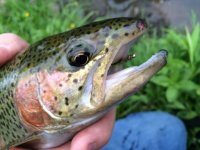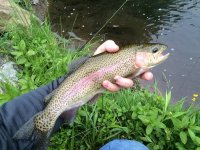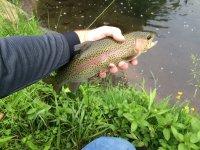mike_richardson
Active member
- Joined
- Mar 29, 2010
- Messages
- 1,564
It is no secret that my favorite way to nymph fish is with an indicator. I don't know what it is but watching that indi rip up stream has the same effect for me that many dry fly fisherman like when the trout comes up and wacks their fly. Stupid I know, but it is what trips my trigger. I can catch fish with Czech, high sticking, all that other jazz, but I like the no fuss no muss way of fishing. Heck I use a hand tied tapered leader to a barrel swivel and use 4-6# fluorocarbon for my tippet. It works, I catch fish, and I am happy. I spend more time with flies in the water than I do fighting with blood knots 
Some days however the old faithful indicator and dead drift wont cut it. Often if the water is lower it is tough to detect the strikes with it. So I reluctantly switch methods. Some times I leave the indicator on to help me see the general area where the flies are. My eyes are not the best anymore.
Well this morning before work I snuck to my honey hole and had about 15 minutes to fish. My first cast yielded a nice 10" hold over bow. The trout hit a grey squirrel nymph. I know there are a pile of fish in this hole, but after 5 minutes of no more takers I figured I was either not detecting the strikes, or the fish did not want the dead drifted nymphs.
I could see a few trout actively feeding mid water coloumn, so I figured I would try and use the "Leisenring Lift" technique. Now it is probably more technical than how I was doing it, and I am sure others know more about how to do this but here is what I was doing.
I knew a few of the key feeding lies on the hole, and a few of the structures that would hold the fish. I kept the indicator on for a reference to know where my flies were. Most would take it off, but it helps me quickly keep tabs. You would probably be a lot better off without one
I would pitch out up stream at roughly a 45 degree angle and let the flies get to the bottom. Once my indicator would be above where i felt the fish were I would start to slowly lift the flies up. I like to almost pause a little or dip my wrist back down as I am lifting. The rod would be pretty much straight out in front of me at this point, and I would be lifting the flies up and down stream.
I believe what this is representing is nymphs coming up off of the bottom to hatch. My first lift yielded a nice brookie about 9".
I took him off and gave it a go again. One of the key things about this that you need to remember is pinching the line with you rod hand between one of your fingers. If you don't it is easy to lose tension, and not get a good hookset. The fish will often hook itself on the lift as they are going to take you fly and swim back down. If you keep tension you will feel the fish take it, they will feel the hook and dart down, setting the hook. A quick lift of the rod, and the fish will hook itself.
I was having a blast and just about every cast or every other cast yielded a fish. I had about 2 minutes to spare, before I get out of the 10 minutes early comfort zone for work, when my lift got hammered.
I set the hook and my drag was screaming pretty good. I knew I had a nice fish on. THe water temps were pretty low with the cold snap but I still wanted to make the fight short, as I imagine the oxygen levels are a bit lower right now.
I brought to hand a really pretty rainbow. I knew he was in the hole as my son had lost him on a salmon egg/waxworm combo about a week or 2 before.
My go to fly "peeping caddis" as I like to call it, and the name my uncle who showed me the pattern reference,( "peeking caddis" is its real name), did the trick on a few of the fish I brought to hand. You can see it a little in this fishes mouth.
I like to tie mine with ultra chenille as the peeping section, ruffed grouse hackle for the legs/sticks of the caddis case, holographic tinsel for the rib, and grey squirrel for the body. I substitute hares mask dubbing as well. All colors will work but the grey squirrel is best IMO.
Anyway, I snapped these pics real quick, and was getting my fly out the trout flopped into the water, and snapped my fly off.
Figures as I am out of the ultra chenille I use to tie the pattern. I may try some chartreuse yarn this time around, and save some money.
I am not great at this method and I hope some others who would out fish me any day can chime in with some better tips and explanations. I am all ears on this as I want to get better at different techniques. But it is worth a little research if you never heard of it or tried it. I also believe the creator was from PA.
Thanks for the read,
Mike
Some days however the old faithful indicator and dead drift wont cut it. Often if the water is lower it is tough to detect the strikes with it. So I reluctantly switch methods. Some times I leave the indicator on to help me see the general area where the flies are. My eyes are not the best anymore.
Well this morning before work I snuck to my honey hole and had about 15 minutes to fish. My first cast yielded a nice 10" hold over bow. The trout hit a grey squirrel nymph. I know there are a pile of fish in this hole, but after 5 minutes of no more takers I figured I was either not detecting the strikes, or the fish did not want the dead drifted nymphs.
I could see a few trout actively feeding mid water coloumn, so I figured I would try and use the "Leisenring Lift" technique. Now it is probably more technical than how I was doing it, and I am sure others know more about how to do this but here is what I was doing.
I knew a few of the key feeding lies on the hole, and a few of the structures that would hold the fish. I kept the indicator on for a reference to know where my flies were. Most would take it off, but it helps me quickly keep tabs. You would probably be a lot better off without one
I would pitch out up stream at roughly a 45 degree angle and let the flies get to the bottom. Once my indicator would be above where i felt the fish were I would start to slowly lift the flies up. I like to almost pause a little or dip my wrist back down as I am lifting. The rod would be pretty much straight out in front of me at this point, and I would be lifting the flies up and down stream.
I believe what this is representing is nymphs coming up off of the bottom to hatch. My first lift yielded a nice brookie about 9".
I took him off and gave it a go again. One of the key things about this that you need to remember is pinching the line with you rod hand between one of your fingers. If you don't it is easy to lose tension, and not get a good hookset. The fish will often hook itself on the lift as they are going to take you fly and swim back down. If you keep tension you will feel the fish take it, they will feel the hook and dart down, setting the hook. A quick lift of the rod, and the fish will hook itself.
I was having a blast and just about every cast or every other cast yielded a fish. I had about 2 minutes to spare, before I get out of the 10 minutes early comfort zone for work, when my lift got hammered.
I set the hook and my drag was screaming pretty good. I knew I had a nice fish on. THe water temps were pretty low with the cold snap but I still wanted to make the fight short, as I imagine the oxygen levels are a bit lower right now.
I brought to hand a really pretty rainbow. I knew he was in the hole as my son had lost him on a salmon egg/waxworm combo about a week or 2 before.
My go to fly "peeping caddis" as I like to call it, and the name my uncle who showed me the pattern reference,( "peeking caddis" is its real name), did the trick on a few of the fish I brought to hand. You can see it a little in this fishes mouth.
I like to tie mine with ultra chenille as the peeping section, ruffed grouse hackle for the legs/sticks of the caddis case, holographic tinsel for the rib, and grey squirrel for the body. I substitute hares mask dubbing as well. All colors will work but the grey squirrel is best IMO.
Anyway, I snapped these pics real quick, and was getting my fly out the trout flopped into the water, and snapped my fly off.
Figures as I am out of the ultra chenille I use to tie the pattern. I may try some chartreuse yarn this time around, and save some money.
I am not great at this method and I hope some others who would out fish me any day can chime in with some better tips and explanations. I am all ears on this as I want to get better at different techniques. But it is worth a little research if you never heard of it or tried it. I also believe the creator was from PA.
Thanks for the read,
Mike






